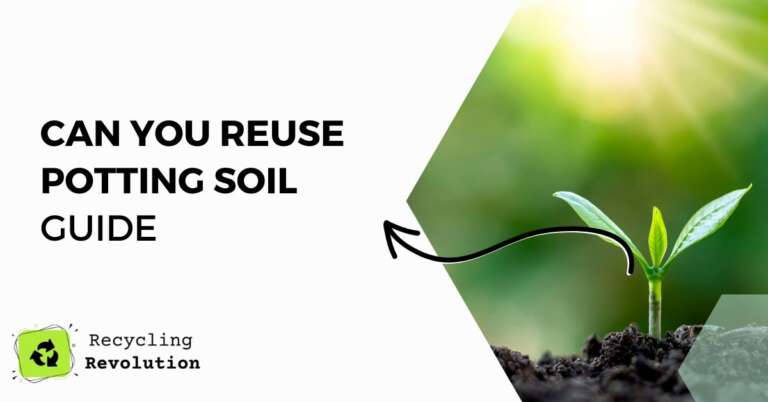Potting soil is the mixture of ingredients that makes a high-quality potting medium.
Organic matter, such as peat moss, is commonly used in potting soil to create air pockets and improve drainage.
Is reusing potting soil possible? Yes.
Although potting soil can be reused, it may affect the growth of your plants.
Fresh potting soil is always preferable, and there are several reasons why soil loses its air pockets and ability to drain.
There are certainly some basic actions you can do to prepare your potting soil for planting again, at least for another year or two.
These additional components assist plants in thriving in a pot or container, which lacks the organic matter, moisture and nutrients, that plants in the ground do.
Is it necessary to refresh potting soil before reuse?
Following the farming practice of crop rotation and simply growing a different type of plant, the following season is one key to success when reusing potting soil.
This is especially true for tomato potting soil because these high-energy plants tend to zap the growing medium.
When you’ve decided what to plant, use these tips to improve used potting soil
Begin by inspecting the potting soil and stirring it with your fingers or a hand rake in a large sieve a few quarts at a time.
This will fluff it up again, allowing you to remove and discard any large seeds, roots, or clumps.
Fertilizer in fresh potting mix only lasts three to six months, so you may want to add fertilizer in a ratio appropriate for the plants you intend to grow next.
Due to a lack of peat moss, the potting mix may have become more acetic.
Grow acid-loving plants like azaleas or bleeding heart, or add some garden lime to raise the pH.
What is the Lifespan of Potting Soil?
A 25-quart bag of potting soil costs about $10, so it’s not dirt cheap! This is especially true considering that a 10-inch standard clay pot typically requires three gallons of potting soil.
Most potting soil may persist for two years because peat moss has a two-year lifetime.
Store it in a climate-controlled area, sealed in its original bag or equivalent covered container, to keep it as fresh as possible.
Gardeners should be able to reuse leftover potting soil as long as it is fluffy and smells good.
If the plants previously grown in the potting soil had disease or pest issues, it’s generally advisable to dump the mix and start over next season.
Aside from a hard consistency and an unpleasant odor, other symptoms that potting soil has gone bad include white areas that indicate mold growth and the presence of visible pests such as gnats.
If the plants previously grown in the potting soil experienced disease or insect problems, it’s usually best to discard the mix and start again the following season.
Benefits for Used Potting Soil
Much of my old potting soil is no longer utilized to pot up plants.
Despite its lack of nutrients, ancient potting soil still contains perlite nuggets, humus threads, and relatively few weed seeds.
As a result, it is an excellent material for covering newly planted carrots, beets, and other slow-growing seeds.
A topdressing of moisture-retaining potting soil improves seed germination and reduces weed competition.
Used potting soil is also useful when moles, dogs, or other creatures dig holes in the grass that must be filled and fixed.
When grass seed is coated with a thin layer of potting soil, it normally grows quickly and with few weeds.
You may also pot up giveaway plants in old potting soil.
When you put divisions from asters, bee balm, daylilies, and other robust perennials in a broken plastic pot and fill it with old potting soil, it costs nothing.
How to Store Potting Soil?
I keep potting soil used to produce edibles distinct from that used to support flowers, which helps prevent disease carryover from year to year in the same way that rotations do in the vegetable garden.
The soil utilized for flowers this year can be used for food the following year, and vice versa.
Bins, small garbage cans, or heavy-duty plastic bags are all suitable storage containers for keeping the soil dry.
Freezing temperatures are beneficial to stored potting soil because they make life difficult or impossible for any insects present as adults, pupae, or eggs.
Used potting soil might produce unexplained hatches when stored in warm circumstances.
The Risks of Soil Recycling
There are two basic reasons why reusing potting soil might endanger plants.
Pathogens, viruses, fungus, bacteria, nematodes, and other disease-carrying organisms can be found in used soil.
These infections can make container plants sick and kill them.
Used soil may also be low in nutrients required by plants.
This can also cause plants to grow ill and perish.
Ways to help reduce the risks of using potting soil
How can potting soil be reused without damaging your plants?
Try these easy techniques.
Never reuse soil from a diseased plant-infected container
The plant may be dead and gone, but the infections and other issues in the soil persist, increasing the likelihood that the next tenant will become ill and die.
Before using old potting soil, pasteurize it
Weed seeds, diseases, and/or insects are frequently found in soil that remains in pots exposed to the weather, none of which are ideal in a growth medium.
Bake the soil in the sun to destroy these hazardous substances.
To begin, place the used dirt in black plastic bags or the bags should then be placed in a sunny position.
The same pasteurization process that occurs during ordinary composting will take place within the bags when temperatures increase within the mix, rendering pathogens, weed seeds, and other unwanted materials inert.
Although old soil can also be placed in garbage cans or sealable five-gallon buckets, garbage bags are very convenient to transport, and the black plastic ones retain heat well.
After planting, fertilize your pots
The elements weather the soil, causing nutrients to leak out.
To combat this, use fertilizer to ensure that your container plants receive the nutrients they require.
This is especially critical if you’re using recycled potting soil, since many of the vital minerals may have been eaten up by plants or leached out the previous year.
Use a slow-release fertilizer that will last the entire growth season or alternatively, every two weeks, use a liquid fertilizer such as urine tea.
Mix in some compost and new potting mix with the old, especially if you’ve been using the same soil for a long time.
Exposure to the elements also compacts the soil.
Adding fresh potting mix to old will not only make it more fertile, but it will also make it more friable and retain moisture.
If you’ve been using the same soil for a while, it’s usually a good idea to make a 50-50 mix of half-old and half-fresh potting soil.
To minimize salt accumulation, water with rainfall.
Is there white crusting on the surface of the soil in your planters?
Then it might be suffering from salt accumulation, which can stifle plant growth.
Water your container plants with rainfall to avoid this problem in the future.
Rainwater often has less salt than tap or well water.
What about recycling salty soil in containers?
Don’t Put it in your compost bin and If you truly want to use it in pots, combine it with 50% fresh potting soil.
By including old nursery pots into the mix, you may use less soil
This method is illustrated in the image below.
Because the old nursery pot takes up some space, less soil is required to fill the larger pot.
Conclusion
Potting soil that looks and smells good after two years may still have some benefits.
Rather than risking it in containers, consider incorporating regular garden soil into raised beds or in-ground plots.
Potting soil can also be used to add volume and organic matter to a compost pile.

